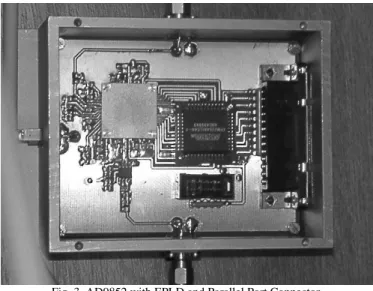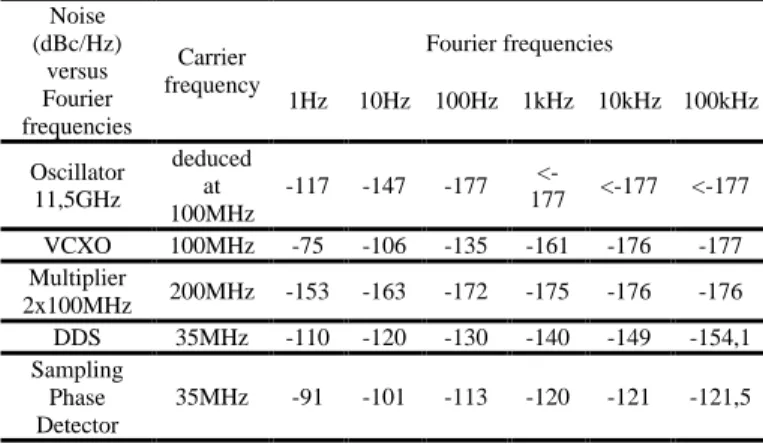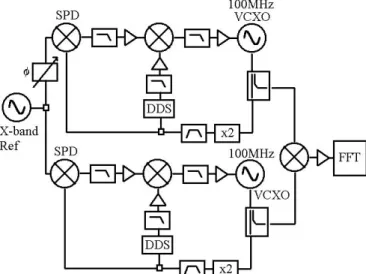HAL Id: hal-00022876
https://hal.archives-ouvertes.fr/hal-00022876
Submitted on 14 Apr 2006
HAL is a multi-disciplinary open access
archive for the deposit and dissemination of
sci-entific research documents, whether they are
pub-lished or not. The documents may come from
teaching and research institutions in France or
abroad, or from public or private research centers.
L’archive ouverte pluridisciplinaire HAL, est
destinée au dépôt et à la diffusion de documents
scientifiques de niveau recherche, publiés ou non,
émanant des établissements d’enseignement et de
recherche français ou étrangers, des laboratoires
publics ou privés.
Design and realisation of a 100MHz synthesis chain from
an X-band reference signal
Franck Lardet-Vieudrin, Patrice Salzenstein, David Vernier, Daniel Gillet,
Michel Chaubet, Vincent Giordano
To cite this version:
Franck Lardet-Vieudrin, Patrice Salzenstein, David Vernier, Daniel Gillet, Michel Chaubet, et al..
Design and realisation of a 100MHz synthesis chain from an X-band reference signal. 2003,
pp.560-564. �hal-00022876�
Abstract – LPMO has undertaken the building of a cryogenic
sapphire oscillator with the support of th french Space and Metrolgy agencies (CNES and BNM). The aim of this project is to provide a reference oscillator presenting short frequency stability better than 5.10-14 in order to fulfill reference tests requirements for spacial and metrological applications [1]. The cryogenic oscillator can operate on different frequencies ranging from 8 to 13GHz depending on the sapphire resonator mode chosen as reference. The exact output signal frequency is not ‘a priori’ known with a great accuracy due to the large relative uncertainties (of the order of 10-4) affecting the resonator frequencies theoritical determination. Then a special synthesis chain has to be designed in order to transfert the cryogenic oscillator performances to a reference signal whose frequency is fully compatible with most of Time and Frequency instrumentation. In this paper, we present the design, realization and preliminary tests of a synthesis chain generating a 100MHz signal from an X-band reference. The performances of the two realyzed prototypes will enable to transfert better than 5.10-14 short term frequency stability.
Keywords - Synthesis, 100MHz, X-band, DDS, Sampling Phase
Detector
I.INTRODUCTION
Ultra-stable signals are now available in our laboratory from cryogenic sapphire oscillator in X-band [1]. This oscillator has been developped with the support of the Centre National de la Recherche Spatiale (CNES) and Bureau National de Métrologie (BNM) to provide an efficient tool for metrological measurements. Indeed the qualification tests of the new generation of on-board USO and synthesis systems requires the availability of a reference presenting frequency instabilities well below 5.10-14 on the short term.
Moreover the same reference are needed for the interrogating oscillator used in newly developped frequency standards based on cold atoms [2]. Our cryogenic oscillator is based on a 50 mm diameter high sapphire resonator operating on a Whispering Galllery Mode (WGM) near liquid Helium temperature. Several quasi transverse magnetic WGM separated by about 600MHz can be chosen as frequency reference.
Table I gives the frequency and the turn over temperatures of the most interesting modes of our sapphire resonator. The frequency stability of cryogenic oscillator is better than 2.10-14 for τ<100s.
TABLE I
FREQUENCIES, TURN-OVER TEMPERATURE, RANK OF THE USEFULL HARMONIC AND BEAT SIGNAL OF THE MOST INTERSTING MODES OF THE SAPPHIRE RESONATOR
Mode designation ν (GHz) T0 (K) n ∆ν (MHz) WGH13,0,0 9.747 7.33 98 53 WGH14,0,0 10.353 7.66 104 47 WGH15,0,0 10.959 6.61 110 41 WGH16,0,0 11.565 6.42 116 35 WGH17,0,0 12.170 6.60 122 30 WGH18,0,0 12.774 6.58 128 26
The transfert of the cryogenic oscillator frequency stability to a 100MHz signal will be achieved by phase locking a 100MHz VCXO on a sapphire signal using the scheme given on figure 1.
Fig. 1. Principle of the synthesis chain.
Sapphire and a high rank harmonic of the VCXO signals are comparated in a Samplig Phase Detector (SPD) used as a Sampling Mixer, in order to produce a beat signal in the range 20-50MHz. In Table I, the rank n of the usefull harmonic and the beat signal frequency are given. The PLL error signal is then obtained by mixing the beat note with the output of a Direct Digital Synthesis (DDS) referenced to a 200MHz signal coming from the VCXO frequency multiplied by 2, is needed to synthetize signal of to 50MHz. Eventually, this error signal is supplied to the VCXO varicap to lock th loop. The use of a 48 bit DDS enables to achieve frequency of the order of 1.10-16 compatible with expected frequency accuracy of cold atoms frequency standards. Intrinsic phase noise of the synthesis chain components will limit the short term frequency stability of the 100MHz outut signal. We present in this paper the measurement of individual components phase noise and the test of the overall system.
DESIGN AND REALISATION OF A 100MHz SYNTHESIS CHAIN FROM
AN X-BAND REFERENCE SIGNAL
F. Lardet-Vieudrin
1, P. Salzenstein
1, D. Vernier
1, D. Gillet
1,
M. Chaubet
2and V. Giordano
11Laboratoire de Physique et de Métrologie des Oscillateurs – CNRS UPR3203, associé à l’Université de FrancheComté, 32 avenue de l’Observatoire, F25044 Besançon Cedex, FRANCE, Phone: +33 381853974 Fax: +33 381853998
-e-mail: patrice.salzenstein@lpmo.edu
II. MULTIPLIER
The 100MHz signal from the VCXO is multiplied by two by this component. To obtain 200MHz from the 100MHz signal, we choose to send this signal through a 90°hybrid to the LO and RF of a mixer as schematized on figure 2. Actually, this configuration allow the lowest phase noise, compared to commercial multipliers and active multipliers using transistors. This comparizon has been made by the use of interferometric measurements at 100MHz [3].
Fig. 2. Principle of the designed multiplier.
The 200MHz signal is used both to clock the DDS and to provide the LO signal of the SPD. The rejection of 100MHz pump signal and its harmonics 300 and 400MHz is better than 65 dBc. The phase noise power spectral density of two identical multipliers measured at 200MHz is given in figure 5 and Table II.
III. DIRECT DIGITAL SYNTHESIS
For Direct Digital Synthesis we use an AD9852 commercial model developped by Analog Device Company that uses a 48 bits phase accumulator, a 14 bits ouput converter and a working frequency that can be as higher as 300MHz. This model has been designed for numerical telecommunications applications.
Fig. 3. AD9852 with EPLD and Parallel Port Connector.
There are several modes to be used, the fondamental one called single-tone is the most usefull for our application. It generate a sine signal by scrutation of a wave-table and digital-analogic conversion.
The frequency delivered by the DDS is : Fsignal=(p/2
48
).Fref (1) where p is the incrementation step of the phase accumulator defined as a 48 bits unsigned integer.
As 248 is closed to 1014.5, the frequency resolution at 35MHz is closed to one microHertz.
We developed a card for the DDS with a driving module based on a Electrical Programable Logic Device (EPLD) that manage the parallel port from a personal computer. It allows the programmation of the DDS registers. In order to drain the heating because of the electrical consumption of the DDS, we put a copper thermal drain bridge that can be seen at the left on the picture. The 35MHz output signal power is only –5dBm. Then an amplifier stage has been placed at the DDS output with an anti-aliasing filter. The rejection of the filtering-amplification stage is greater than 40dBc on the harmonics of the 35MHz Intermediary Frequency (IF).
IV. SAMPLING MIXER
Fig. 4. Principle of the phase noise measurement of the Sampling Mixers.
-180 -170 -160 -150 -140 -130 -120 -110 -100 -90 -80 -70 -60 -50 -40 -30 -20 -10 0 1 10 100 1000 10000 100000 Sampling Mixers - SPD - @ 11.565G DDS Multipliers - x 2
Fig. 5. Spectral density of phase noise Sφ (dB.rad²/Hz) versus Fourier frequencies (Hz) respectively from the top to the bottom for SPD, DDS and
Multipliers.
This component, developped by Avitronics in South Africa, is protected by a radiator in order to operate at room temperature with an internal 36°C measured temperature for a 0dBm microwave input power. Spectral density of phase noise has been measured on two SPD by rejecting the microwave signal delivered by a synthetizer splittered onto both SPDs, and LO pump signal was made of the
multiplication of the 100MHz from the VCXO. The 35MHz output signal phase noise of two SPD is represented in figure 5.
For one SPD, £(f)=-101dBc/Hz at 10Hz. Between 1Hz and 10Hz, the slope is a little bit higher than a 1/f slope. It could traduce the sensitivity of the SPD to the 11.5GHz ‘RF’ and 200MHz ‘LO’ signals. That is why we assume that the SPD introduce a noise £(f)=-91dBc/Hz at 1Hz.
V. NOISE PERFORMANCES
For each components of the synthesis chain, the performances are presented on table II in terms of spectral density of phase noise versus Fourier frequencies.
TABLE II
SYNTHESIS CHAIN COMPONENT PHASE NOISE VERSUS FOURIER FREQUENCIES
Fourier frequencies Noise (dBc/Hz) versus Fourier frequencies Carrier frequency 1Hz 10Hz 100Hz 1kHz 10kHz 100kHz Oscillator 11,5GHz deduced at 100MHz -117 -147 -177 <-177 <-177 <-177 VCXO 100MHz -75 -106 -135 -161 -176 -177 Multiplier 2x100MHz 200MHz -153 -163 -172 -175 -176 -176 DDS 35MHz -110 -120 -130 -140 -149 -154,1 Sampling Phase Detector 35MHz -91 -101 -113 -120 -121 -121,5
VI. NOISE OF THE SYNTHETIZED SIGNAL AT 100MHz
From the contributions of each element of the synthesis chain, can be deduced the final noise level of the delivered signal at 100MHz. The noise level of the 100MHz synthetized signal can be estimated from the contributions of each preceding components. Assuming the phase lock loop in operation the error voltage fluctuations ∆V is given by:
∆V=K/p.( ∆ωi-∆ωj) (2)
Where:
K is the sensitivity of the mixer in mV/rad
p is the Laplace’s variable, and ωi and ωj are defined by: ∆ωi=∆ωRef-n. ∆ω0+∆ωx2 (3) ∆ωj=m. ∆ωS-m/2. ∆ωx2+∆ωDDS (4) ∆ωS , ∆ωRef are the frequency fluctuations of the locked VCXO and the microwave reference respectively.
∆ω0DS , ∆ωx2 , ∆ωSPD are the frequency fluctuations introduced by the DDS, the multiplier by two, the sampling mixer, due to their intrinsic phase noise ∆ω=1/p.∆Φ.
Fig. 6. Schematic representation.
- n defined in Table I
- m the ratio between the output frequency of the DDS and 100MHz
Fig. 7. The two synthesis chains
At the output of the VCXO, the signal is defined by:
ωS=ω0+KVCO. ∆V (5) Where KVCO the VCXO tunning constant in Hz/V.
The spectral density of phase noise SϕS can then be expressed using (6), by considering a time constant τ that depend on the characteristic of the synthesis chain:
(
2)
0 . 4. ² 1 . ² ² ² 4 1 1 . ² ² ² 4 1 ² ² ² 4 x SPD DDS ref S S S S S n f S f f S ϕ ϕ ϕ ϕ τ π ϕ τ πτ π ϕ + + + + + + = (6)Noise budget and limit are given in figure 8.
Fig. 8. Noise budget.
Two identical synthesis chains has been built in order to measure the noise of the system.
Their phase noise was measured by rejecting an X-band CW microwave signal.
Fig. 9. Principle of the phase noise measurement of the two realized synthesis chains.
Although different frequencies were tested in X-band, we only present here the results for a 11.5GHz signal for a 0dBm input power.
The noise of the 100MHz output frequencies synthetized from the chains is given in the figure 10. For other input
frequencies corresponding to the other sapphire resonance mode, the obtained phase noise is about the same.
-180 -170 -160 -150 -140 -130 -120 -110 -100 -90 -80 -70 -60 0.01 0.1 1 10 100 1000 10000 100000 Synthesis chain @11,565GHz
Fig. 10. Performances of the 100MHz synthetized signals in terms of Spectral density of phase noise Sφ (dB.rad²/Hz) versus Fourier frequencies
(Hz)
VII. DISCUSSION
By considering the two synthesis chains identical, we deduce the residual phase noise level of the synthetized signal at 100MHz. Results are given versus Fourier frequencies between 0.01Hz and 100kHz on table III.
TABLE III
PHASE NOISE OF THE SYNTHESIS CHAIN
Fourier frequencies 0,01 Hz 0,1 Hz 1 Hz 10 Hz 100 Hz 1 kHz 10 kHz 100 kHz Noise of the synthetized signal at 100MHz (dBc/Hz) -101 -116 -131 -141 -153 -160 -169 -172
For an oscillator in X-band delivering a high stability signal with σy =2.10
-14
at τ=10s, typicaly obtained in our laboratory for cryogenic resonator-oscillator saphire-based [1], 100MHz equivalent signal presents a level of noise £(f)=–120 dBc/Hz at 1Hz from the carrier with a 1/f3 slope. The synthesis chain will be able to reproduce the 100MHz equivalent signal for Fourier frequencies lower than few Hertz, i.e. frequency stability of the VCXO follows the one of the cryogenic resonator-oscillator for τ>1s. Further from the carrier, the noise performance of the synthesis chain is mainly limited by the noise of the SPD. Moreover, phase lock loop produced a bump in the phase noise level just before Fourier frequency of 10kHz. Further away, the phase noise floor is limited by the VCXO.
REFERENCES
[1] P.Y. Bourgeois, Y. Kersalé, N. Bazin, M. Chaubet and V. Giordano, Cryogenic opened cavity sapphire resonator for ultra stable oscillator, paper ELL 38056 accepted for publication in Electronics Letters, 2003.
[2] A. G. Mann, G. Santarelli, S. Chang, A. N; Luiten, Ph. Laurent, C. Salomon, D. G. Blair and A. Clairon, A high stability atomic fountain clock using a cryogenic sapphire interrogation oscillator, Proc. IEEE IFCS, Pasadena, CA, USA, 1998, pp. 13-17.
[3] E. Rubiola and V. Giordano, Advanced interferometric phase and amplitude noise measurements, Review of Scientific Instruments, Vol. 73, No 6, June 2002, pp. 2445-2457.



